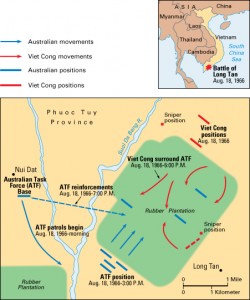^Australian troops wait to board U.S. Army helicopters bound for the Australian Task Force Base at Nui Dat, near Long Tan, Vietnam. Credit: Mike Coleridge, Australian War Memorial
Australian veterans of the Vietnam War (1957-1975) were frustrated this week when the Vietnamese government canceled a memorial event planned for August 18. The day marks Australia’s annual Vietnam Veterans Day, but this year’s holiday carries extra significance. August 18, 2016, marks the 50th anniversary of the Battle of Long Tan, Australia’s first major conflict in the Vietnam War. In that battle, a small group of soldiers from Australia and New Zealand defeated a much larger enemy force. The war is a sensitive subject for the Vietnamese government, who canceled the event the day before it was due to take place. More than 1,000 Australians had already traveled to Vietnam for the ceremony.
Australia’s involvement in the Vietnam War began in 1962, when the country sent Army advisers to South Vietnam in support of its allies from the United States. The first drafted Australian soldiers arrived in Vietnam in 1966. That year, the Australians began to set up a base at Nui Dat, about 3 miles (5 kilometers) west of the village of Long Tan. The base was about 70 miles (110 kilometers) east of Saigon (now Ho Chi Minh City), the South Vietnamese capital.
On August 17, the Viet Cong (Communist-led South Vietnameseguerrillas) fired artillery at Nui Dat. The next day, a group of Australian soldiers searched for the Viet Cong at a rubber plantation near Long Tan. The group, led by Major Harry Smith, consisted of 105 Australians and 3 New Zealanders. They soon encountered a group of Viet Cong troops that experts estimate was about 2,000 strong.

Battle of Long Tan
Credit: WORLD BOOK map
In a monsoon rain, Smith’s force fought the Viet Cong. American and Australian forces supported Smith’s company with artillery fired from the base at Nui Dat. After about three hours of fighting, and after Smith’s group had fought off several waves of Viet Cong attacks, Australian reinforcements arrived. Nightfall and the arrival of the reinforcements ended the battle.
Seventeen Australian soldiers died in the battle. Twenty-four others were injured, and one of those died of his injuries several days later. The Australians buried 245 Viet Cong soldiers after the battle, though captured documents indicated that hundreds of others had been killed.
A memorial called the Long Tan Cross marks the site of the battle. This year, in addition to Vietnam Veterans Day celebrations across Australia, a group of Australian veterans was scheduled to hold a low-key service at the battle site itself before a “friendship dinner” with Vietnamese veterans and a memorial concert. On August 17, however, the Vietnamese government decided to allow only small groups to access to the battle site for a limited amount of time, and the dinner and concert were canceled.
One of those who traveled to Vietnam for the ceremony was retired Lieutenant Colonel Harry Smith, who recently made a successful petition to the Australian government to have 10 of his men receive military honors for their actions during the battle, or to have existing honors upgraded.
View more Behind the Headline stories in World Book Online!
When you need fast, reliable information for homework, reports, or just a lingering question, World Book Online is the place to go.
- A colorful, approachable look and feel, designed for kids, and articles written at your student's level
- Easy access on smartphones and tablets
- Five complete databases for multiple research levels
- Illustrations, maps, audio files, videos, eBooks, primary source documents, and more
Learn More | Buy Now